翻译第二讲
第二讲直译与意译

It may or may not closely follow the form or organization of the original text.
Confucianism holds that one should give up one's life, if necessary, either passively or actively, for the sake of upholding the cardinal moral values of ren and yi.
“三纲”即“君为臣纲”、“父为子纲”、 “夫为妻纲 ”
the three cardinal guides : ruler guides subject father guides son husband guides wife
rén (仁). Rén is the virtue of perfectly fulfilling one's responsibilities toward others, most often translated as "benevolence" or "humaneness";
Kong Qiu (孔丘), as Confucius is commonly known, is a combination of his surname (孔) and his given name (丘), and he was also known as Zhong Ni (仲尼), which is his
第二讲 翻译定义标准语义翻译
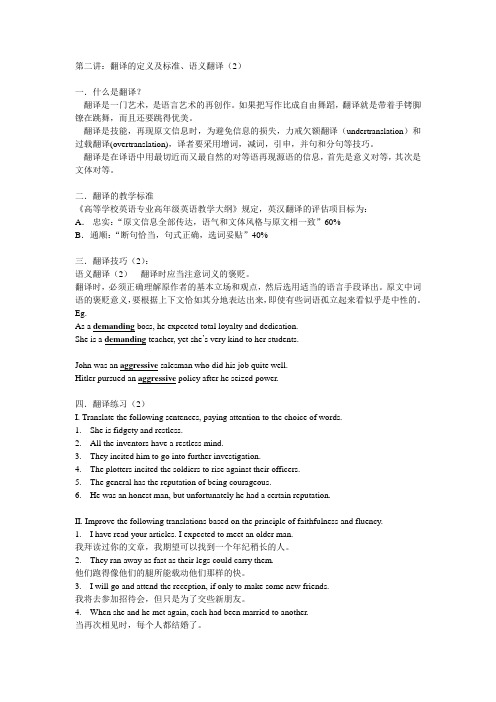
第二讲:翻译的定义及标准、语义翻译(2)一.什么是翻译?---翻译是一门艺术,是语言艺术的再创作。
如果把写作比成自由舞蹈,翻译就是带着手铐脚镣在跳舞,而且还要跳得优美。
---翻译是技能,再现原文信息时,为避免信息的损失,力戒欠额翻译(undertranslation)和过载翻译(overtranslation),译者要采用增词,减词,引申,并句和分句等技巧。
---翻译是在译语中用最切近而又最自然的对等语再现源语的信息,首先是意义对等,其次是文体对等。
二.翻译的教学标准《高等学校英语专业高年级英语教学大纲》规定,英汉翻译的评估项目标为:A.忠实:“原文信息全部传达,语气和文体风格与原文相一致”60%B.通顺:“断句恰当,句式正确,选词妥贴”40%三.翻译技巧(2):语义翻译(2)---翻译时应当注意词义的褒贬。
翻译时,必须正确理解原作者的基本立场和观点,然后选用适当的语言手段译出。
原文中词语的褒贬意义,要根据上下文恰如其分地表达出来,即使有些词语孤立起来看似乎是中性的。
Eg.As a demanding boss, he expected total loyalty and dedication.She is a demanding teacher, yet she’s very kind to her students.John was an aggressive salesman who did his job quite well.Hitler pursued an aggressive policy after he seized power.四.翻译练习(2)I. Translate the following sentences, paying attention to the choice of words.1.She is fidgety and restless.2.All the inventors have a restless mind.3.They incited him to go into further investigation.4.The plotters incited the soldiers to rise against their officers.5.The general has the reputation of being courageous.6.He was an honest man, but unfortunately he had a certain reputation.II. Improve the following translations based on the principle of faithfulness and fluency.1.I have read your articles. I expected to meet an older man.我拜读过你的文章,我期望可以找到一个年纪稍长的人。
3翻译第二讲--翻译标准(理论归纳性较强,后面英汉对照部分可用)

History of Argument “案本---求真---神似---化境” 案本---求真---神似---化境” 案本---求真---神似---化境
严复“ 严复“信、达、雅” 林语堂“ 林语堂“忠、顺、美” 梁实秋、 宁错务顺” 梁实秋、赵景琛 “宁错务顺” 鲁迅“宁信不顺” 鲁迅“宁信不顺” 瞿秋白“信顺统一” 瞿秋白“信顺统一” 傅雷“形似神似” 傅雷“形似神似” 钱钟书“入化境界” 钱钟书“入化境界”
■言内意义是语言符号之间的关系,它具体体现在语音、词汇、句法和 言内意义是语言符号之间的关系,它具体体现在语音、词汇、 语篇等层次。语音层次主要包括各种音韵(如头韵、元音迭韵、和声、 语篇等层次。语音层次主要包括各种音韵(如头韵、元音迭韵、和声、 押韵)、格律及重读等方面;词汇层次有谐音双关、一语双叙等; )、格律及重读等方面 押韵)、格律及重读等方面;词汇层次有谐音双关、一语双叙等;句法 层次有组合关系、排比、倒装等;篇章则有句式的变化、 层次有组合关系、排比、倒装等;篇章则有句式的变化、段落的安排和 衔接、 衔接、粘连等
余光中“变通的艺术” 余光中“变通的艺术”
“翻译如婚姻,是一种两相妥协的艺术。譬 翻译如婚姻,是一种两相妥协的艺术。 翻译如婚姻 如英文译成中文,既不能西风压倒东风, 如英文译成中文,既不能西风压倒东风, 变成洋腔洋调的中文, 变成洋腔洋调的中文,也不许东风压倒西 变成油腔滑调的中文, 风,变成油腔滑调的中文,则东西之间势 必相互妥协,以求‘两全之计’ 必相互妥协,以求‘两全之计’。至于妥 协到什么程度,以及哪一方应该多让一步, 协到什么程度,以及哪一方应该多让一步, 神而明之,变通之道, 神而明之,变通之道,就要看每一位译者 自己的修养了。 自己的修养了。”
Pound’s version: THE JEWEL STAIRS’ GRIEVANCE The jeweled steps are already quite white with dew, It is so late that the dew soaks my gauze stockings, And I let down the crystal curtain And watch the moon through the clear autumn. BY Rihaku
第二讲翻译学的基本概念

• 宁信而不顺(鲁迅语) rather to be faithful than smooth (“I’d rather be faithful than smooth”) • 神似(傅雷语) spiritual resemblance • 化境(钱钟书语)sublimation(升华) • 信、达、切(刘重德语)faithfulness, expressiveness and closeness (to the original style) • 三美: 音美, 形美, 意美(许渊冲语)the three beauties: beauty in sound, beauty in form and bea• •
选词diction 补偿compensation 视点转换shift of perspective 套译/仿译/仿拟imitation 信/忠实faithfulness/ 达/易懂intelligibility/expressiveness 通顺smoothness 流畅fluency 自然naturalness /idiomaticity(语言的表达习惯) 雅/优美elegance/gracefulness
• • • • • • • • •
东方语言Oriental languages 西方语言Occidental languages 佛经Buddhist Scriptures/sutra['su:trə] 梵语Sanskrit 鸠摩罗什Kumarajiva 泰特勒(Alexander Fraser )Tytler 奈达(Eugene A.) Nida 机器翻译machine translation(MT) 人工智能artificial intelligence(AI)
注意:英译汉中长句化短即采用分译法的 依据是:英语多用长句,汉语多用中短 句。长句化短要根据翻译实际需要为转 移。
第二讲:词汇翻译(上)

词汇翻译技巧 3.介词增减:英译汉时很多介词可以省略, 3.介词增减:英译汉时很多介词可以省略,汉译英时 介词增减
则需根据英语的行文需要增加适当的介词。 则需根据英语的行文需要增加适当的介词。
1)She was one of my colleagues at the ) university at which I taught. 她是我任教的那所大学的同事。 她是我任教的那所大学的同事。 2)I get positively angry with the ) impertinence of it and the everlastingness. 这么卤莽无礼,没完没了,真让我生气。 这么卤莽无礼,没完没了,真让我生气。 3)他已经把这事忘得一干二净了。 )他已经把这事忘得一干二净了。 He has forgotten all about it. 4)接到信时我高兴得跳了起来。 )接到信时我高兴得跳了起来。 I jumped with joy when I received the letter.
词汇翻译技巧 移植法 直接移植:在译文中将原文的词语原封不动地 直接移植: 挪用过来。如“卡拉 厅”、KTV包房 、“BP 挪用过来。 卡拉OK厅 、 包房”、 卡拉 包房 唱盘”、 光片 光片”、 发了一份 发了一份e-mail”、 机”、“CD唱盘 、“X光片 、“发了一份 、 唱盘 、 “进入 进入WTO”、“Word文件”、“如何执行 进入 、 文 、 如何执行 Windows 2000的应用程序”、“股票ABC”、 2000的应用程序 的应用程序”、“股票 股票ABC”、 NBA、CIA、IBM、IQ、EQ等等,汉语短语或句 等等, 、 、 、 、 等等 子中夹杂的这些英语单词就是直接移植过来的。 子中夹杂的这些英语单词就是直接移植过来的。 直接移植似乎多应用于科技翻译和新闻媒体 文学翻译则少见。 中,文学翻译则少见。
高口翻译第二讲转译法
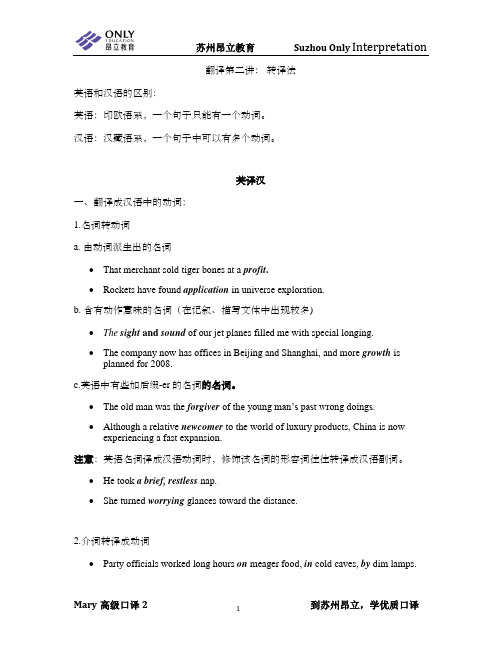
翻译第二讲:转译法英语和汉语的区别:英语:印欧语系,一个句子只能有一个动词。
汉语:汉藏语系,一个句子中可以有多个动词。
英译汉一、翻译成汉语中的动词:1.名词转动词a. 由动词派生出的名词∙That merchant sold tiger bones at a profit.∙Rockets have found application in universe exploration.b. 含有动作意味的名词(在记叙、描写文体中出现较多)∙The sight and sound of our jet planes filled me with special longing.∙The company now has offices in Beijing and Shanghai, and more growth is planned for 2008.c.英语中有些加后缀-er的名词的名词。
∙The old man was the forgiver of the young man’s past wrong doings.∙Although a relative newcomer to the world of luxury products, China is now experiencing a fast expansion.注意:英语名词译成汉语动词时,修饰该名词的形容词往往转译成汉语副词。
∙He took a brief, restless nap.∙She turned worrying glances toward the distance.2.介词转译成动词∙Party officials worked long hours on meager food, in cold caves, by dim lamps.∙“Coming!” Away she skimmed over the lawn, up the path, up the steps, across the veranda, and into the porch.3.形容词转译成动词∙It was a very informative meeting.∙He is not very mindful of personal gains and losses.二、翻译成汉语中的名词:1.名词派生的动词:∙Most satellites are designed to burn up after completing their missions.∙Continuous fighting has mainly characterized their relationship.注意:英语动词译成汉语名词时,修饰该动词的副词往往转译成形容词∙The film “The Sound of Music” impressed him deeply.∙The President had prepared carefully for his journey.2. 有些英语被动式句子中的动词,可以译成“受(遭)到……+名词”、“予(加)以+名词”这类结构。
第二讲:汉译英的特点与翻译
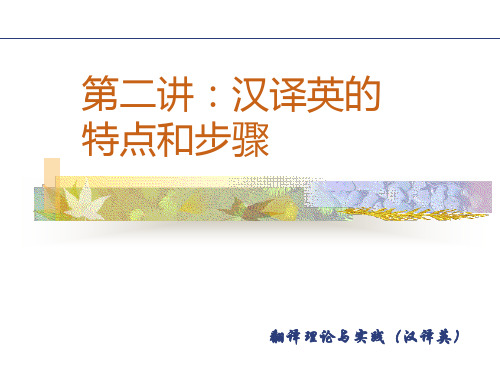
他妻子拿着一个盘子走过去,他连一句话也没跟她 说。 He said no word to his wife as she passed with a plate.
看到这惨状,大家立即陷入了恐慌。 译文1. On seeing this miserable scene, people got panic-stricken very soon. 译文2. At the sight of this miserable scene, people was seized with panic/overwhelmed by panic/great terror, or people were thrown in panic. 译文3. The sight of this miserable scene threw people in panic.
6-5 Passable translation with some inaccuracies The translation adequately reflects most of the original passage with occasional errors of vocabulary, syntax, spelling or punctuation. The translation is, for the most part, readable. 4-3 Inadequate translation with frequent inaccuracies half, with frequent errors; in some parts, unreadable 2-1 Poor translation less than half Almost all sentences contain errors of… For the most part, unreadable
翻译实践 第二讲.ppt
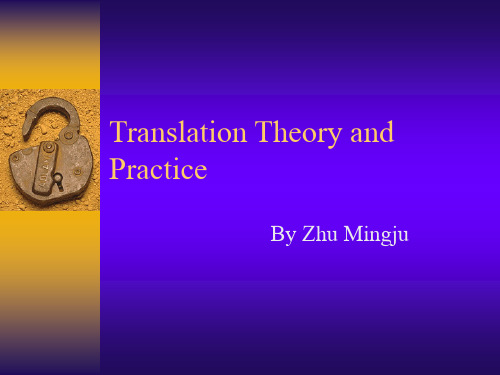
What is Translation?
Not an easy question. Some of definitions
Translation, essentially, is the faithful representation, in one language, of what is written or said in another language. —Zhong Shukong A Handbook of Translation What is translation? Often, though not by any means always, it is rendering the meaning of a text into another language in the way the author intended the text. —Peter Newmark A Textbook of Translation
What is Translation
…aesthetics, linguistics, rhetoric, psychology, so on and so forth.
A polyseme: the process or the product; written translation only or both written translation and interpretation.
Translation: A Long History
The Tower of Babe: in the valley of Shinar According to historians:
the earliest translation activities in China: Zhou dynasty (1100.BC); and in the west: the first traces date from 3000 BC, during the Egyptian Old Kingdom and the first translator was a Greek slave Livius Andronicus, who in about 240 B.C. put the Odyssey into Latin verse. In China
英汉互译第2讲短语和搭配的翻译

supervision and operation; (一前一后) • the state assets management, supervision and operation
14
整理ppt
5)科教兴国战略 6)国有资产管理、监督和运营机制 7)高新技术产业化示范工程 8) 科技成果市场化、产业化 9) 处理合同争议所适用的法律
15
整理ppt
• 1)毛入学率 • the gross enrollment rate 2)中央/地方财政预算 the central and local budgets 3)支持东北老区振兴的政策 Policies rejuvenating the old industrial basis of Northeast
Sinclair (1991) 指出,自由选择原则 (the open-choice principle) 和熟语原则 (the idiom principle)在语言中同时起 作用。前者指按语法规则进行选择;后者则强调说话者构 造语言时,拥有大量提前预制好的语块。
语块是英语的基本语言单位,也是英语学习的基本单位和 理想单位。语块教学是提高学习者语言地道性和流利性的8 关键所在。
8)科技成果市场化、产业化 commercialization and industrialization of scientific and technological achievements
9) 处理合同争议所适用的法律 Law applicable to the settlement of contract disputes
考研英语翻译(第二讲)
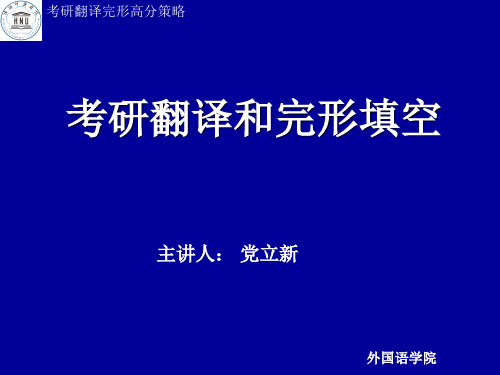
考研翻译完形高分策略
1.2.1.1动词与宾语被分隔
By contrast, they saw
主语they 和谓语 saw 介词短语作时间状 语
由when引导的定语 从句修饰preceding hundred years from 1650 to 1750
in the preceding hundred years from 1650 to 1750,
3. 如果是介词短语,又分两种情况。如(brought..to)充当补足语; 另种情况介词和动词不是搭配,此时介词短语充当状语。
考研翻译完形高分策略
1.2.1.1动词与宾语被分隔
8. On the other hand, he did not accept as well founded the charge made by some of his critics that while he was a good observer, he had no power of reasoning.
在我们的文化中,人们一般认为男同性恋者都较为女性 化,这一点引起了人们的质疑。
考研翻译完形高分策略
1.2.1.1动词与宾语被分隔
7. Widely adknowledged as a great and improtant playwright, Eugene O’neil brought to the United States stage what was probably its first really serious drama. Widely adknowledged as a great and 分词作状语 improtant playwright, Eugene O’neil brought 谓语brought 后面没有直 接带宾语
第二讲 A Psalm of Life翻译鉴赏

第二讲 A Psalm of Life鉴赏·相关背景·亨利·沃兹渥斯·朗费罗,1807-1882,美国诗人。
《人生礼赞》这首诗写于1838年,很快成为一首极富盛名的诗篇。
此诗长达9节,以四步抑扬格写成。
它是一首训教诗,哲理深刻,作者感叹生活的艰辛,劝勉人们要坚韧不拔,不要气馁,要振作,要奋斗,要有所追求,要有所作为,从而使人生的小舟在经过风暴的洗礼之后抵达理想的彼岸。
《人生礼赞》这首诗自发表以来一直广为传诵,直到2000年还被当年的美国桂冠诗人与他人经广泛调查后选定,编入《美国人喜爱的诗》。
本诗还是第一首被译为汉语的欧美诗歌,最早的译文距今已一百多年,赢得了无数中国读者的心。
"A Psalm of Life" is a poem written by American writer Henry Wadsworth Longfellow and was published in October of 1838. It is a poem of encouragement, telling the reader not to waste life. Longfellow is sure to establish that life is real, and it will end soon. He wrote this poem at a fairly young age, yet he has a deep and accurate insight of life.The content of the poem is not especially unique. The speaker is involved in the first person perspective, where he is directly addressing the reader. The tone is neither positive nor negative, but is strictly honest. The tone remains the same "encouraging" style from beginning to end, and there is no change of tone. The only tension found in the poem is that between life and death - Longfellow writes about how every living thing is affected by both conflicting states of being.The word choice in "A Psalm of Life" was obviously carefully picked. An adjective is never repeated, yet the poem reads perfectly. Each word has its own meaning, and its own unique take on life, and every word adds something important, even vital, to the "life" of the poem. The rhythm also flows flawlessly. The rhythm scheme is an eight syllable line followed by a seven syllable line. The poem does not stray from that simple rhythm once.Imagery is the sole method of expression in the poem. Longfellow paints a word picture in each stanza that allows the reader to see more clearly what he is describing. Metaphors and Symbolism is rampant - in fact, the poem is almost entirely comprised of these things.The form of the poem is very basic. Each stanza is four lines long, making the poem a quatrain, and the rhyme scheme follows the pattern "ABAB, CDCD, EFEF..." etc. for each of the nine stanzas. Each stanza also has a recurrent rhythm pattern: 8 syllables, 7 syllables, 8 syllables, 7 syllables. Analyzing the poem even deeper, you will notice that even the punctuation plays an important role. Exclamation points are used to establish emphasis on a particular line. There is no pattern to the punctuation, which makes it even more beneficial to strengthening the meaning of a phrase. Overall, it is very obvious that "A Psalm of Life" is a well thought out poem.词语注解:Psalm:The Book of Psalms, commonly referred to simply as Psalms, is a book of the Hebrew Bible and the Christian Bible. Taken together, its 150 poems express virtually the full range of Israel'sreligious faith. 《诗篇》(《圣经·旧约》中的一卷。
翻译史第二讲
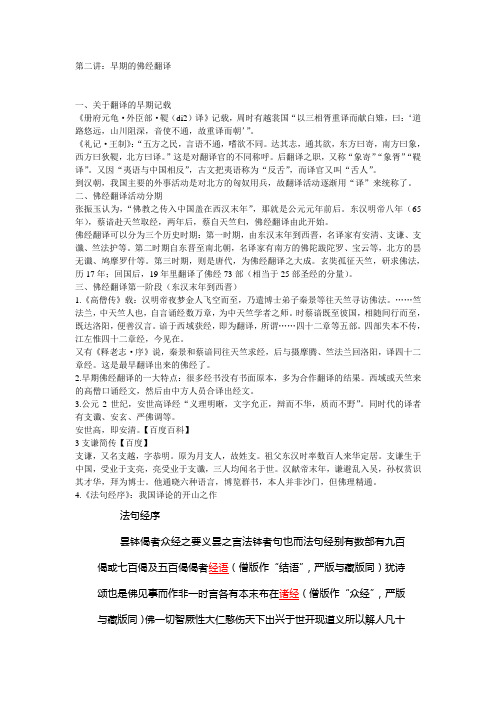
第二讲:早期的佛经翻译一、关于翻译的早期记载《册府元龟·外臣部·鞮(di2)译》记载,周时有越裳国“以三相胥重译而献白雉,曰:‘道路悠远,山川阻深,音使不通,故重译而朝’”。
《礼记·王制》:“五方之民,言语不通,嗜欲不同。
达其志,通其欲,东方曰寄,南方曰象,西方曰狄鞮,北方曰译。
”这是对翻译官的不同称呼。
后翻译之职,又称“象寄”“象胥”“鞮译”。
又因“夷语与中国相反”,古文把夷语称为“反舌”,而译官又叫“舌人”。
到汉朝,我国主要的外事活动是对北方的匈奴用兵,故翻译活动逐渐用“译”来统称了。
二、佛经翻译活动分期张振玉认为,“佛教之传入中国盖在西汉末年”,那就是公元元年前后。
东汉明帝八年(65年),蔡谙赴天竺取经,两年后,蔡自天竺归,佛经翻译由此开始。
佛经翻译可以分为三个历史时期:第一时期,由东汉末年到西晋,名译家有安清、支谦、支谶、竺法护等。
第二时期自东晋至南北朝,名译家有南方的佛陀跋陀罗、宝云等,北方的昙无谶、鸠摩罗什等。
第三时期,则是唐代,为佛经翻译之大成。
玄奘孤征天竺,研求佛法,历17年;回国后,19年里翻译了佛经73部(相当于25部圣经的分量)。
三、佛经翻译第一阶段(东汉末年到西晋)1.《高僧传》载:汉明帝夜梦金人飞空而至,乃遣博士弟子秦景等往天竺寻访佛法。
……竺法兰,中天竺人也,自言诵经数万章,为中天竺学者之师。
时蔡谙既至彼国,相随间行而至,既达洛阳,便善汉言。
谙于西域获经,即为翻译,所谓……四十二章等五部。
四部失本不传,江左惟四十二章经,今见在。
又有《释老志·序》说,秦景和蔡谙同往天竺求经,后与摄摩腾、竺法兰回洛阳,译四十二章经。
这是最早翻译出来的佛经了。
2.早期佛经翻译的一大特点:很多经书没有书面原本,多为合作翻译的结果。
西域或天竺来的高僧口诵经文,然后由中方人员合译出经文。
3.公元2世纪,安世高译经“义理明晰,文字允正,辩而不华,质而不野”。
第二讲:翻译的过程与策略

cientists are often men of supernormal vitality which enables them to retain a freshness of outlook and enterprise even into their old age. • [意译]伟大的科学家往往具有超人的活力,因此,即e 使到了晚年,他们还保有新颖的观点和朝气蓬勃的事 业心。 • Watch out for Harlow, he’s full of mickey mouse ideas. • [字面意义]要小心哈洛,他满脑子都是米老鼠的想法 。 • [意译]要提防着点哈洛,他满脑子歪门邪道。(下流 、不高明的看法)
• 直译
• • • • • • • • A life line The Trojan horse The domino theory Dollar diplomacy A wolf in sheep’s clothing A trump card An ivory tower Man proposes, God disposes
1. 语义分析
• 上下文和词在句中的搭配关系选择词义 • Power can be transmitted over a long distance. • A car needs a lot of power to go fast. • Explosive technological development after1990 gave the medical profession enormous power to fight disease and sickness.
但我们要尽量避免死译或硬译
• The earth acts like a big magnet. • We cannot estimate the value of modern science too much.
第二讲语义翻译
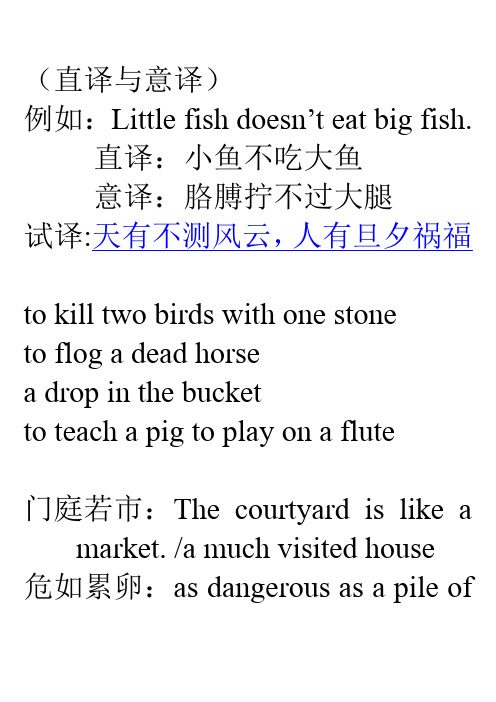
(直译与意译)例如:Little fish doesn’t eat big fish.直译:小鱼不吃大鱼意译:胳膊拧不过大腿试译:天有不测风云,人有旦夕祸福to kill two birds with one stoneto flog a dead horsea drop in the bucketto teach a pig to play on a flute门庭若市:The courtyard is like a market. /a much visited house危如累卵:as dangerous as a pile ofeggs/great insecurity; hazardousin the extreme由于文化对语言的影响,有些语言成分只能意译,而不能直译,这主要体现在受本国文化影响最深的成语和谚语上。
hand in glove with:和...狼狈为奸once in a blue moon: 千载难逢乱七八糟:at sixes and sevens (seven disorders and eight chaos)招风惹草:look for trouble (invite wind to exasperate the grass)It is an ill bird that fouls its own nest.外甥打灯笼---照舅(旧)归化与异化(domestication/adaptation orforeignization / alienation)归化的翻译在理论上是把语言看作交际工具;在实践上,强调通俗易懂,避免多义或歧义。
习惯认为,当原文与译文之间因文化差异而出现不能通达的情况时,“要用译语文化替代原语文化”即把在译语中找不到对等的外语词汇改头换面,或套用译语中与之相似的现成的表达法,把它们变成读者熟悉的译语文化形象。
归化派代表人物尤金•奈达(Eugene A. Nida): Functional Equivalence 功能对等“The receptors of the translated text could respond to it with comprehension and appreciation in essentially the samemanner and to the same degree as the original receptors of the message”;“Translation should arouse the same feeling in its receptors as the feeling of the readers of the original”---- NidaFor instance: as white as snow 通常译为白如雪/ 但没有见过雪的人可以将其翻译为“白如白鹭毛”,以达到功能对等的目的。
英汉翻译第二讲讲义解析
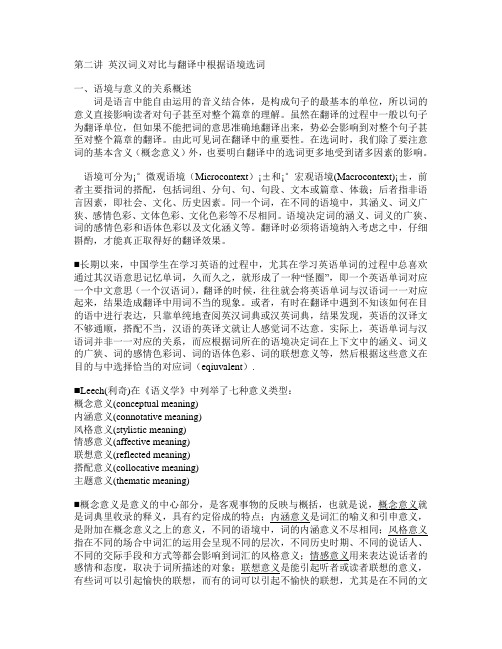
第二讲英汉词义对比与翻译中根据语境选词一、语境与意义的关系概述词是语言中能自由运用的音义结合体,是构成句子的最基本的单位,所以词的意义直接影响读者对句子甚至对整个篇章的理解。
虽然在翻译的过程中一般以句子为翻译单位,但如果不能把词的意思准确地翻译出来,势必会影响到对整个句子甚至对整个篇章的翻译。
由此可见词在翻译中的重要性。
在选词时,我们除了要注意词的基本含义(概念意义)外,也要明白翻译中的选词更多地受到诸多因素的影响。
语境可分为¡°微观语境(Microcontext)¡±和¡°宏观语境(Macrocontext)¡±,前者主要指词的搭配,包括词组、分句、句、句段、文本或篇章、体裁;后者指非语言因素,即社会、文化、历史因素。
同一个词,在不同的语境中,其涵义、词义广狭、感情色彩、文体色彩、文化色彩等不尽相同。
语境决定词的涵义、词义的广狭、词的感情色彩和语体色彩以及文化涵义等。
翻译时必须将语境纳入考虑之中,仔细斟酌,才能真正取得好的翻译效果。
⏹长期以来,中国学生在学习英语的过程中,尤其在学习英语单词的过程中总喜欢通过其汉语意思记忆单词,久而久之,就形成了一种“怪圈”,即一个英语单词对应一个中文意思(一个汉语词),翻译的时候,往往就会将英语单词与汉语词一一对应起来,结果造成翻译中用词不当的现象。
或者,有时在翻译中遇到不知该如何在目的语中进行表达,只靠单纯地查阅英汉词典或汉英词典,结果发现,英语的汉译文不够通顺,搭配不当,汉语的英译文就让人感觉词不达意。
实际上,英语单词与汉语词并非一一对应的关系,而应根据词所在的语境决定词在上下文中的涵义、词义的广狭、词的感情色彩词、词的语体色彩、词的联想意义等,然后根据这些意义在目的与中选择恰当的对应词(eqiuvalent).⏹Leech(利奇)在《语义学》中列举了七种意义类型:概念意义(conceptual meaning)内涵意义(connotative meaning)风格意义(stylistic meaning)情感意义(affective meaning)联想意义(reflected meaning)搭配意义(collocative meaning)主题意义(thematic meaning)⏹概念意义是意义的中心部分,是客观事物的反映与概括,也就是说,概念意义就是词典里收录的释义,具有约定俗成的特点;内涵意义是词汇的喻义和引申意义,是附加在概念意义之上的意义,不同的语境中,词的内涵意义不尽相同;风格意义指在不同的场合中词汇的运用会呈现不同的层次,不同历史时期、不同的说话人、不同的交际手段和方式等都会影响到词汇的风格意义;情感意义用来表达说话者的感情和态度,取决于词所描述的对象;联想意义是能引起听者或读者联想的意义,有些词可以引起愉快的联想,而有的词可以引起不愉快的联想,尤其是在不同的文化中,词的联想意义有很大的区别。
英汉翻译基础教程第2讲 英汉对比[补充资料-学生版本]
![英汉翻译基础教程第2讲 英汉对比[补充资料-学生版本]](https://img.taocdn.com/s3/m/541ea79ae53a580216fcfe1a.png)
第2讲英汉对比[补充资料]综合语(synthetic)的特征是运用形态变化来表达语法关系,拉丁语、德语及古英语等都属于综合语。
分析语(analytic)的特征是不用形态变化而用词序及虚词来表达语法关系,汉语是典型的分析语。
现代英语是从古代英语发展出来的,仍然保留着综合语的某些特征,但是也具有分析语的特点:有形态变化,但不像典型的综合语那么复杂;词序笔汉语灵活,但相对固定;虚词很多,用得也相当频繁。
因此,现代英语属于综合-分析语(synthetic- analytic language)。
从语源(Etymology)观来说,英语属印欧语系(Indo-European Language),汉语则属汉藏语系(Sino-Tibetan language)。
(一)形合与意合:英语重形合(hypotaxis),汉语重意合(parataxis)所谓形合,指的是句中的词语或分句之间用语言形式手段(如关联词)连接起来,表达语法意义和逻辑关系。
意合指的是词语或分句之间不用语言形式手段连接,句中的语法意义和逻辑关系通过词语或分句的含义表达。
英语造句常用各种形式手段连接词、短语、分句或从句,注重显性接应(overt-cohesion),注重句子形式,注重结构完整,注重以形显义。
英语句中的连接手段和形式(cohesive ties)不仅数量大,种类多,而且用得十分频繁。
汉语造句少用甚至不用形式连接手段,注重隐性连贯(covert-coherence),注重逻辑事理顺序,注重功能、意义,注重以神统形。
(汉语介词数量少,大约30个,大多从动词“借”来的。
)1)When I try to understand what it is t hat prevents so many Americans from being as happy as one might expect, it seems to me that there are two causes, of which one goes much deeper than the other. (关系词和连接词)为什么如此众多的美国人不能如想象中那样幸福呢?我认为原因有二,而两者之间又有深浅之分。
翻译第二讲分合译法(2)
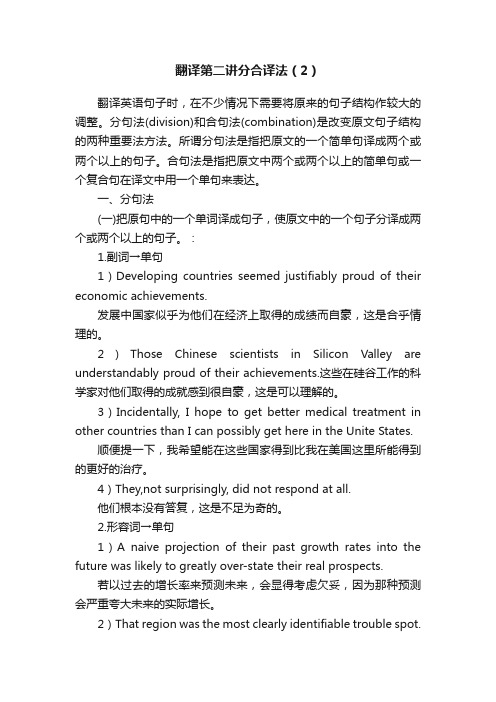
翻译第二讲分合译法(2)翻译英语句子时,在不少情况下需要将原来的句子结构作较大的调整。
分句法(division)和合句法(combination)是改变原文句子结构的两种重要法方法。
所谓分句法是指把原文的一个简单句译成两个或两个以上的句子。
合句法是指把原文中两个或两个以上的简单句或一个复合句在译文中用一个单句来表达。
一、分句法(一)把原句中的一个单词译成句子,使原文中的一个句子分译成两个或两个以上的句子。
:1.副词→单句1)Developing countries seemed justifiably proud of their economic achievements.发展中国家似乎为他们在经济上取得的成绩而自豪,这是合乎情理的。
2)Those Chinese scientists in Silicon Valley are understandably proud of their achievements.这些在硅谷工作的科学家对他们取得的成就感到很自豪,这是可以理解的。
3)Incidentally, I hope to get better medical treatment in other countries than I can possibly get here in the Unite States.顺便提一下,我希望能在这些国家得到比我在美国这里所能得到的更好的治疗。
4)They,not surprisingly, did not respond at all.他们根本没有答复,这是不足为奇的。
2.形容词→单句1)A naive projection of their past growth rates into the future was likely to greatly over-state their real prospects.若以过去的增长率来预测未来,会显得考虑欠妥,因为那种预测会严重夸大未来的实际增长。
旅游英语翻译第二讲

例4:
黄山终日云遮雾罩。尤其雨后,茫茫云海,波诡云谲。忽而 白浪排空,千姿百态。忽而轻歌曼舞,山影如画,绚丽缤纷。 忽而风起云涌,气象万千,美不胜收。 There are always clouds and mist on Huangshan mountain, and the seas of clouds provide spectacular sights, especially after a rain. As they move across the sky, the sea of clouds take on ever-changing looks. When the clouds dance lightly, they give the mountain a poetic charm, and when they surge forward in a strong wind, they offer a sight of imposing grandeur. The unpredictable beauty is beyond description.
第二讲《唐雎不辱使命》翻译
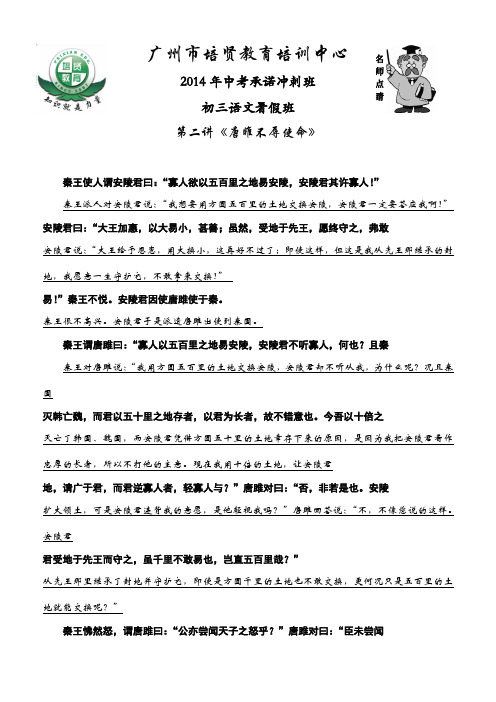
广州市培贤教育培训中心2014年中考承诺冲刺班初三语文暑假班第二讲《唐雎不辱使命》秦王使人谓安陵君曰:“寡人欲以五百里之地易安陵,安陵君其许寡人!” 秦王派人对安陵君说:“我想要用方圆五百里的土地交换安陵,安陵君一定要答应我啊!” 安陵君曰:“大王加惠,以大易小,甚善;虽然,受地于先王,愿终守之,弗敢 安陵君说:“大王给予恩惠,用大换小,这再好不过了;即使这样,但这是我从先王那继承的封地,我愿意一生守护它,不敢拿来交换!”易!”秦王不悦。
安陵君因使唐雎使于秦。
秦王很不高兴。
安陵君于是派遣唐雎出使到秦国。
秦王谓唐雎曰:“寡人以五百里之地易安陵,安陵君不听寡人,何也?且秦秦王对唐雎说:“我用方圆五百里的土地交换安陵,安陵君却不听从我,为什么呢?况且秦国灭韩亡魏,而君以五十里之地存者,以君为长者,故不错意也。
今吾以十倍之灭亡了韩国、魏国,而安陵君凭借方圆五十里的土地幸存下来的原因,是因为我把安陵君看作忠厚的长者,所以不打他的主意。
现在我用十倍的土地,让安陵君地,请广于君,而君逆寡人者,轻寡人与?”唐雎对曰:“否,非若是也。
安陵扩大领土,可是安陵君违背我的意愿,是他轻视我吗?”唐雎回答说:“不,不像您说的这样。
安陵君君受地于先王而守之,虽千里不敢易也,岂直五百里哉?”从先王那里继承了封地并守护它,即使是方圆千里的土地也不敢交换,更何况只是五百里的土地就能交换呢?”秦王怫然怒,谓唐雎曰:“公亦尝闻天子之怒乎?”唐雎对曰:“臣未尝闻 名师点睛秦王勃然大怒,对唐雎说:“先生曾听说过天子发怒吗?”唐雎回答说:“我未曾听说过。
”也。
”秦王曰:“天子之怒,伏尸百万,流血千里。
”唐雎曰:“大王尝闻布衣之秦王说:“天子发怒的时候,倒下的尸体会有百万,血流千里。
”唐雎说:“大王曾经听说过平民发怒吗?”怒乎?”秦王曰:“布衣之怒,亦免冠徒跣,以头抢地耳。
”唐雎曰:“此庸夫之秦王说:“平民发怒,也不过就是摘掉帽子,光着脚,把头往地上撞罢了。
- 1、下载文档前请自行甄别文档内容的完整性,平台不提供额外的编辑、内容补充、找答案等附加服务。
- 2、"仅部分预览"的文档,不可在线预览部分如存在完整性等问题,可反馈申请退款(可完整预览的文档不适用该条件!)。
- 3、如文档侵犯您的权益,请联系客服反馈,我们会尽快为您处理(人工客服工作时间:9:00-18:30)。
B.
东西文化对比与翻译概论
1
文化心理: culture-loaded expressions: Dragon/owl/bull/ cat /green/gray/moon/ landlord/peasant
2
海洋性商业文化 (个体主义)v.s. 大陆性农业文化 (群体主义) 时间观念/空间观 念/对他人的态度/ 工作态度/物质追 求/婚姻/隐私
3
风俗习惯 打招呼/宴席/告辞/称呼 /数字 (2,8,6,9/4) (13)
C. 英汉思维比较与翻译
概述: 傅雷:东方人与西方人之思想方式有基本分歧, 我人重综合,重归纳,重暗示,重含蓄;西方人 则重分析,细微曲折,挖掘唯恐不尽,描写唯恐 不周… 语言与思维存在密不可分的联系。中西方思维模 式的差异,影响到语言的基本结构、用词选句。
1.What is culture?
E. Nida divided culture into : ecology, material culture, social culture, religious culture, organization, customs, concepts, gestures, habits. Including: norms, values, linguistic behavior, nonverbal behavior
3. 褒贬与曲直
英汉语都存在着对一个事物的褒贬态度,但问题 是,许多场合中,褒贬的含义并不能从字面或词 汇本身中看出来,往往要通过上下文来决定,翻 译时要尽量正确理解原文,表现真实的含义。 A:英语中有些词本身就有褒贬,汉译时相应译出。 He was a man of high renown. 译文:他是位有名望的人。(褒) His notoriety as a rake did not come until his death. 译文:他作为流氓的恶名是他死后才传开来的。 (贬)
1. 直率与含蓄
西方人喜外露,中国人喜含蓄。英语经常表态在 前,叙事在后;汉语经常相反。英汉对译时,信 息中心常需做前后调整。 例如:I am very happy to receive your message of greetings. 译文:接到你的贺信,我十分高兴。 The two sides found it beneficial to have this opportunity to present to one another their views on a variety of issues. 译文:现在有机会互相介绍彼此对各种问题的观 点,对此,双方认为是有利的。
2. Relationship between language, culture and translating
Translation : inter-lingual transmission, cross-cultural transmission Bi-cultural competence, cultural awareness
2. 逻辑与感悟
英语注重运用各种有形的联结手段达到语法形式 的完整,其表现形式严密地受逻辑形式支配,句 子组织严密,层次井然扣接,以形显义; 汉语在表现形式上受意念引导,看上去概念、判 断、推理不严,句子松散,以神统形,要靠读者 自己去推理和感悟。 举例: 让世界了解中国,让中国走向世界。 Let the other people of the rest of the world know China. Let China make close contact with the rest of the world.
2. Relationship between language, culture and translating
Culture involves every aspect of life. Words only have meaning in terms of culture. Cultural awareness is very important. Language is a part of culture and can reflect /transmit culture. Biculturalism is more important than bilingualism.
3.Examples of culture-loaded expressions
离休干部: a retired cadre? retired veteran cadre 工读学校: part-time school? reformatory for juvenile delinquency? 半路出家:switch to one job one is not trained for
[Image information in product] ● Title Master- www.iclickart.co.kr - Image licensed by affiliates ● Slide Master –www.iclickart.co.kr - Image licensed by affiliates ● Note to customers: This image has been licensed to be used within this PowerPoint template only. You may not extract the image for any other use.
1. 直率与含蓄
1. To my no small astonishment, I found the house on fire. 2. You could have come at a better time. 3. She has much more than just a pretty face. 4. I’m terribly sorry to interrupt you, but I wonder if you would be so kind as to lower your voices a little.
3. 褒贬与曲直
B: 英语中有些词义是中立的,翻译时应根据上 下文做褒贬取舍。 He was a man of integrity, but unfortunately he had a certain reputation. I believe the reputation was not deserved. 译文:他是一个正直诚实的人,但不幸有某种坏 坏 名声。我相信他这个坏名声 坏名声是不该有的。(贬) 名声 坏名声 Practice: She was vexed by the persistent ringing of the phone.
LOGO
二 英汉文化对比
Content
文化的定义
A
Bபைடு நூலகம்
东西文化对比与翻译概论. 东西文化对比与翻译概论.
C
英汉思维比较与翻译
A. 文化的定义
1.What is culture?
Tytler: Culture is the complex whole which includes knowledge, belief, art, law, morals, customs, and any other capabilities and habits acquired by man, as a member of society. Peter Newmark: culture is the way of life and its manifestations that are peculiar to a community that uses a particular language as its means of expression.
LOGO
